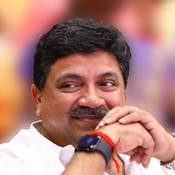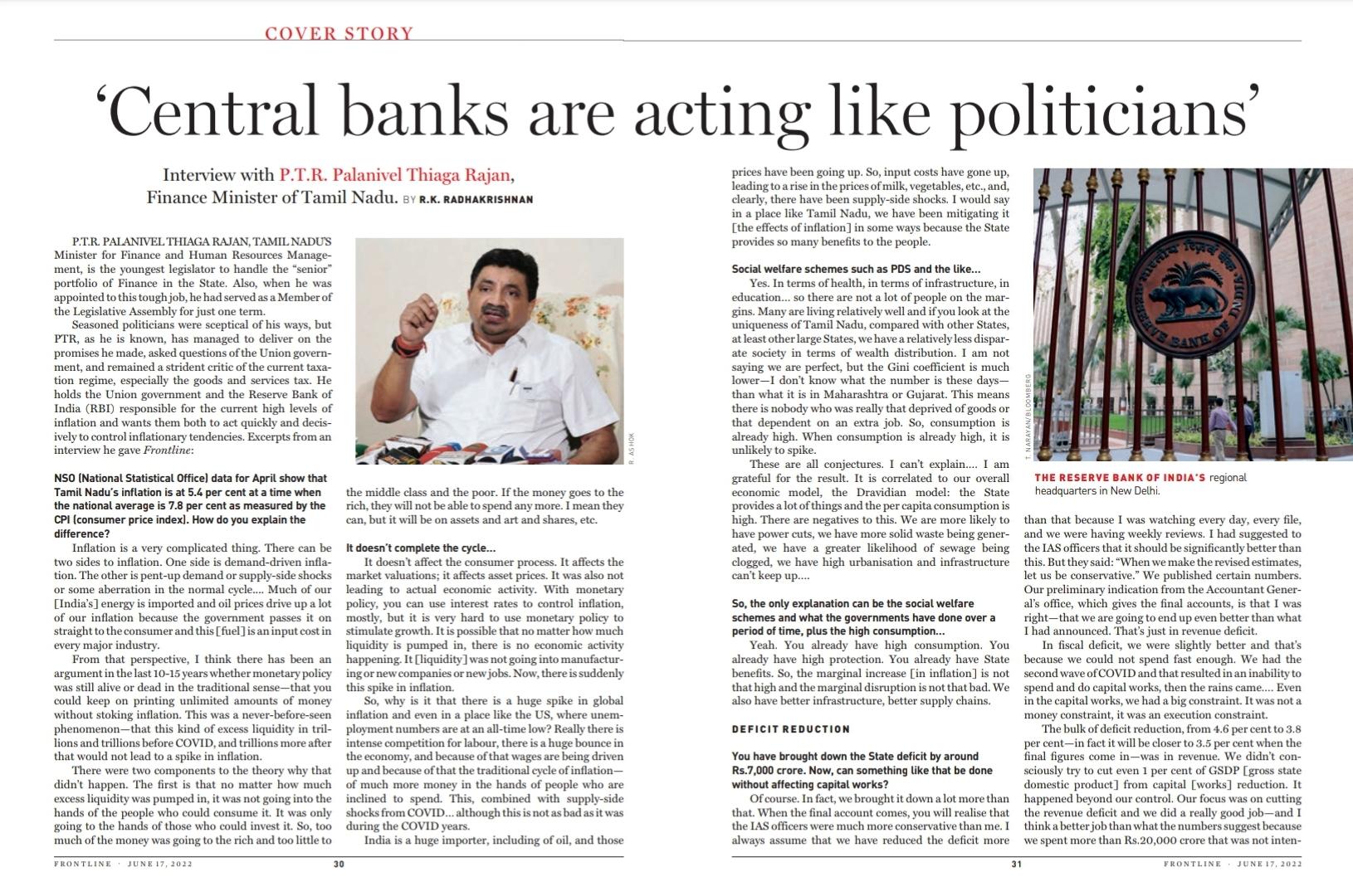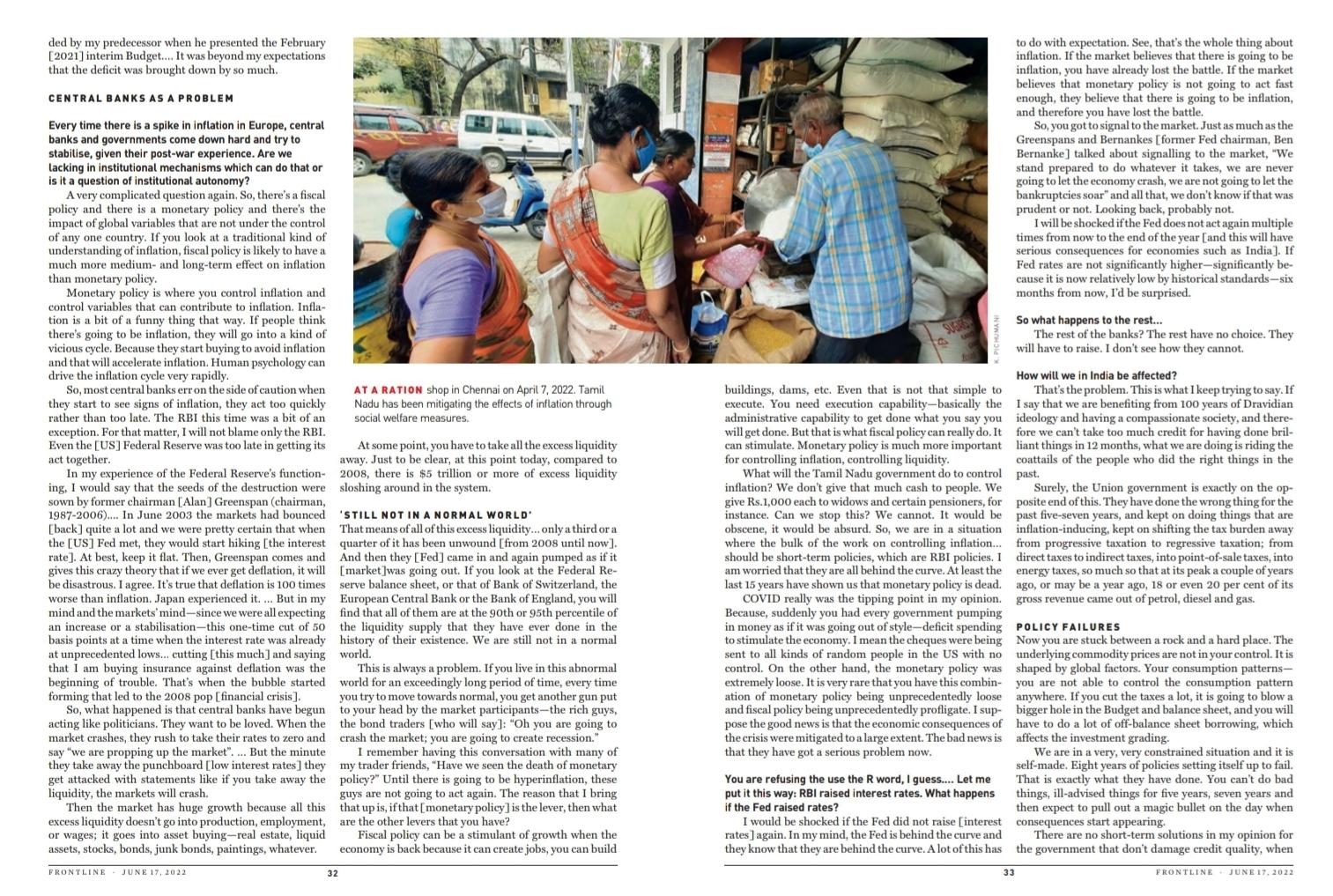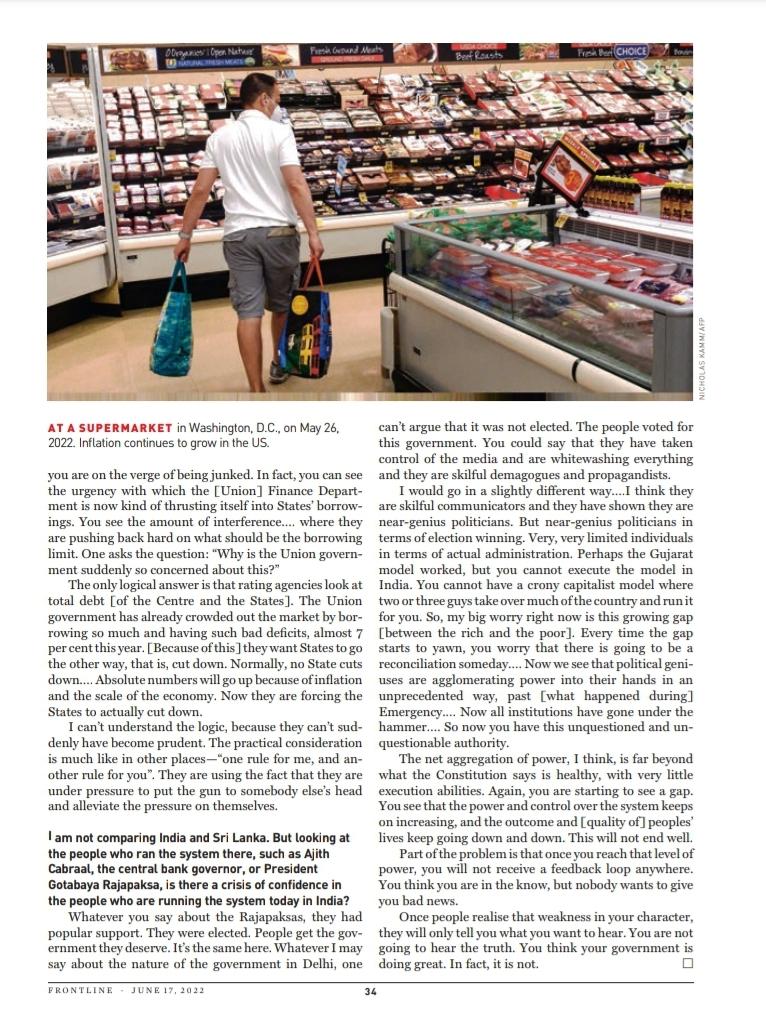

Published Date: June 2, 2022
CATEGORY: ECONOMY
P.T.R. PALANIVEL THIAGA RAJAN, TAMIL NADU’S Minister for Finance and Human Resources Management, is the youngest legislator to handle the “senior” portfolio of Finance in the State. Also, when he was appointed to this tough job, he had served as a Member of the Legislative Assembly for just one term.
Seasoned politicians were sceptical of his ways, but PTR, as he is known, has managed to deliver on the promises he made, asked questions of the Union government, and remained a strident critic of the current taxation regime, especially the goods and services tax. He holds the Union government and the Reserve Bank of India (RBI) responsible for the current high levels of inflation and wants them both to act quickly and decisively to control inflationary tendencies. Excerpts from an interview he gave Frontline:
NSO (National Statistical Office) data for April show that Tamil Nadu’s inflation is at 5.4 percent at a time when the national average is 7.8 percent as measured by the CPI (consumer price index). How do you explain the difference?
Inflation is a very complicated thing. There can be two sides to inflation. One side is demand driven inflation. The other is pentup demand or supply side shocks or some aberration in the normal cycle.... Much of our [India’s] energy is imported and oil prices drive up a lot of our inflation because the government passes it on straight to the consumer and this [fuel] is an input cost in every major industry.
From that perspective, I think there has been an argument in the last 10, 15 years whether monetary policy was still alive or dead in the traditional sense—that you could keep on printing unlimited amounts of money without stoking inflation. This was a never before seen phenomenon—that this kind of excess liquidity in trillions and trillions before COVID, and trillions more after that would not lead to a spike in inflation.
There were two components to the theory why that didn’t happen. The first is that no matter how much excess liquidity was pumped in, it was not going into the hands of the people who could consume it. It was only going to the hands of those who could invest it. So, too much of the money was going to the rich and too little to the middle class and the poor. If the money goes to the rich, they will not be able to spend any more. I mean they can, but it will be on assets and art and shares, etc.
It doesn’t complete the cycle…
It doesn’t affect the consumer process. It affects the market valuations; it affects asset prices. It was also not leading to actual economic activity. With monetary policy, you can use interest rates to control inflation, mostly, but it is very hard to use monetary policy to stimulate growth. It is possible that no matter how much liquidity is pumped in, there is no economic activity happening. It [liquidity] was not going into manufacturing or new companies or new jobs. Now, there is suddenly this spike in inflation.
So, why is it that there is a huge spike in global inflation and even in a place like the US, where unemployment numbers are at an all time low? Really there is intense competition for labour, there is a huge bounce in the economy, and because of that wages are being driven up and because of that the traditional cycle of inflation— of much more money in the hands of people who are inclined to spend. This, combined with supply side shocks from COVID… although this is not as bad as it was during the COVID years.
India is a huge importer, including of oil, and those prices have been going up. So, input costs have gone up, leading to a rise in the prices of milk, vegetables, etc., and, clearly, there have been supply side shocks. I would say in a place like Tamil Nadu, we have been mitigating it [the effects of inflation] in some ways because the State provides so many benefits to the people.
Social welfare schemes such as PDS and the like…
Yes. In terms of health, in terms of infrastructure, in education… so there are not a lot of people on the margins. Many are living relatively well and if you look at the uniqueness of Tamil Nadu, compared with other States, at least other large States, we have a relatively less disparate society in terms of wealth distribution. I am not saying we are perfect, but the Gini coefficient is much lower—I don’t know what the number is these days— than what it is in Maharashtra or Gujarat. This means there is nobody who was really that deprived of goods or that dependent on an extra job. So, consumption is already high. When consumption is already high, it is unlikely to spike.
These are all conjectures. I can’t explain.… I am grateful for the result. It is correlated to our overall economic model, the Dravidian model: the State provides a lot of things and the per capita consumption is high. There are negatives to this. We are more likely to have power cuts, we have more solid waste being generated, we have a greater likelihood of sewage being clogged, we have high urbanization and infrastructure can’t keep up….
So, the only explanation can be the social welfare schemes and what the governments have done over a period of time, plus the high consumption…
Yeah. You already have high consumption. You already have high protection. You already have State benefits. So, the marginal increase [in inflation] is not that high and the marginal disruption is not that bad. We also have better infrastructure, better supply chains.
DEFICIT REDUCTION
You have brought down the State deficit by around Rs.7,000 crore. Now, can something like that be done without affecting capital works?
Of course. In fact, we brought it down a lot more than that. When the final account comes, you will realize that the IAS officers were much more conservative than me. I always assume that we have reduced the deficit more than that because I was watching every day, every file, and we were having weekly reviews. I had suggested to the IAS officers that it should be significantly better than this. But they said: “When we make the revised estimates, let us be conservative.” We published certain numbers. Our preliminary indication from the Accountant General’s office, which gives the final accounts, is that I was right—that we are going to end up even better than what I had announced. That’s just the revenue deficit.
In the fiscal deficit, we were slightly better and that’s because we could not spend fast enough. We had the second wave of COVID and that resulted in an inability to spend and do capital works, then the rains came.… Even in the capital works, we had a big constraint. It was not a money constraint, it was an execution constraint.
The bulk of deficit reduction, from 4.6 per cent to 3.8 per cent—in fact it will be closer to 3.5 per cent when the final Figures come in—was in revenue. We didn’t consciously try to cut even 1 percent of GSDP [gross state domestic product] from capital [works] reduction. It happened beyond our control. Our focus was on cutting the revenue deficit and we did a really good job—and I think a better job than what the numbers suggest because we spent more than Rs.20,000 crore that was not intended by my predecessor when he presented the February[2021] interim Budget.… It was beyond my expectations that the deficit was brought down by so much
CENTRAL BANKS AS A PROBLEM
Every time there is a spike in inflation in Europe, central banks and governments come down hard and try to stabilize, given their post war experience. Are we lacking in institutional mechanisms which can do that or is it a question of institutional autonomy?
A very complicated question again. So, there’s a fiscal policy and there is a monetary policy and there’s the impact of global variables that are not under the control of any one country. If you look at a traditional kind of understanding of inflation, fiscal policy is likely to have a much more medium and long term effect on inflation than monetary policy.
Monetary policy is where you control inflation and control variables that can contribute to inflation. Inflation is a bit of a funny thing that way. If people think there’s going to be inflation, they will go into a kind of vicious cycle. Because they start buying to avoid inflation and that will accelerate inflation. Human psychology can drive the inflation cycle very rapidly.
So, most central banks err on the side of caution when they start to see signs of inflation, they act too quickly rather than too late. The RBI this time was a bit of an exception. For that matter, I will not blame only the RBI. Even the [US] Federal Reserve was too late in getting its act together.
In my experience of the Federal Reserve’s functioning, I would say that the seeds of the destruction were sown by former chairman [Alan] Greenspan (chairman, 19872006).... In June 2003 the markets had bounced [back] quite a lot and we were pretty certain that when the [US] Fed met, they would start hiking [the interest rate]. At best, keep it flat. Then, Greenspan comes and gives this crazy theory that if we ever get deflation, it will be disastrous. I agree. It’s true that inflation is 100 times worse than inflation. Japan experienced it. … But in my mind and the markets’ mind—since we were all expecting an increase or a stabilization—this onetime cut of 50 basis points at a time when the interest rate was already at unprecedented lows… cutting [this much] and saying that I am buying insurance against deflation was the beginning of trouble. That’s when the bubble started forming that led to the 2008 pop [financial crisis].
So, what happened is that central banks have begun acting like politicians. They want to be loved. When the market crashes, they rush to take their rates to zero and say “we are propping up the market”. … But the minute they take away the punch board [low interest rates] they get attacked with statements like if you take away the liquidity, the markets will crash.
Then the market has huge growth because all this excess liquidity doesn’t go into production, employment, or wages; it goes into asset buying—real estate, liquid assets, stocks, bonds, junk bonds, paintings, whatever.
At some point, you have to take all the excess liquidity away. Just to be clear, at this point today, compared to 2008, there is $5 trillion or more of excess liquidity sloshing around in the system.
‘ STILL NOT IN NORMAL WORLD ’
That means of all of this excess liquidity… only a third or a quarter of it has been unwound [from 2008 until now]. And then they [Fed] came in and again pumped as if it [market]was going out. If you look at the Federal Reserve balance sheet, or that of Bank of Switzerland, the European Central Bank or the Bank of England, you will find that all of them are at the 90th or 95th percentile of the liquidity supply that they have ever done in the history of their existence. We are still not in a normal world.
This is always a problem. If you live in this abnormal world for an exceedingly long period of time, every time you try to move towards normal, you get another gun put to your head by the market participants—the rich guys, the bond traders [who will say]: “Oh you are going to crash the market; you are going to create recession.”
I remember having this conversation with many of my trader friends, “Have we seen the death of monetary policy?” Until there is going to be hyperinflation, these guys are not going to act again. The reason that I bring that up is, if that [monetary policy] is the lever, then what are the other levers that you have?
Fiscal policy can be a stimulant of growth when the economy is back because it can create jobs, you can build buildings, dams, etc. Even that is not that simple to execute. You need execution capability—basically the administrative capability to get done what you say you will get done. But that is what fiscal policy can really do. It can stimulate. Monetary policy is much more important for controlling inflation, controlling liquidity.
What will the Tamil Nadu government do to control inflation? We don’t give that much cash to people. We give Rs.1,000 each to widows and certain pensioners, for instance. Can we stop this? We cannot. It would be obscene, it would be absurd. So, we are in a situation where the bulk of the work on controlling inflation… should be short term policies, which are RBI policies. I am worried that they are all behind the curve. At least the last 15 years have shown us that monetary policy is dead.
COVID really was the tipping point in my opinion. Because, suddenly you had every government pumping in money as if it was going out of style—deficit spending to stimulate the economy. I mean the cheques were being sent to all kinds of random people in the US with no control. On the other hand, the monetary policy was extremely loose. It is very rare that you have this combination of monetary policy being unprecedentedly loose and fiscal policy being unprecedentedly profligate. I suppose the good news is that the economic consequences of the crisis were mitigated to a large extent. The bad news is that they have got a serious problem now.
You are refusing the use the R word, I guess.… Let me put it this way: RBI raised interest rates. What happens if the Fed raised rates?
I would be shocked if the Fed did not raise [interest rates] again. In my mind, the Fed is behind the curve and they know that they are behind the curve. A lot of this has to do with expectation. See, that’s the whole thing about inflation. If the market believes that there is going to be inflation, you have already lost the battle. If the market believes that monetary policy is not going to act fast enough, they believe that there is going to be inflation, and therefore you have lost the battle.
So, you got to signal to the market. Just as much as the Greenspans and Bernankes [former Fed chairman, Ben Bernanke] talked about signaling to the market, “We stand prepared to do whatever it takes, we are never going to let the economy crash, we are not going to let the bankruptcies soar” and all that, we don’t know if that was prudent or not. Looking back, probably not.
I will be shocked if the Fed does not act again multiple times from now to the end of the year [and this will have serious consequences for economies such as India]. If Fed rates are not significantly higher—significantly because it is now relatively low by historical standards—six months from now, I’d be surprised.
So what happens to the rest…
The rest of the banks? The rest have no choice. They will have to raise. I don’t see how they cannot.
How will we in India be affected?
That’s the problem. This is what I keep trying to say. If I say that we are benefiting from 100 years of Dravidian ideology and having a compassionate society, and therefore we can’t take too much credit for having done brilliant things in 12 months, what we are doing is riding the coattails of the people who did the right things in the past.
Surely, the Union government is exactly on the opposite end of this. They have done the wrong thing for the past five seven years, and kept on doing things that are inflation inducing, kept on shifting the tax burden away from progressive taxation to regressive taxation; from direct taxes to indirect taxes, into point of sale taxes, into energy taxes, so much so that at its peak a couple of years ago, or may be a year ago, 18 or even 20 percent of its gross revenue came out of petrol, diesel and gas.
POLICY FAILURES
Now you are stuck between a rock and a hard place. The underlying commodity prices are not in your control. It is shaped by global factors. Your consumption patterns— you are not able to control the consumption pattern anywhere. If you cut the taxes a lot, it is going to blow a bigger hole in the Budget and balance sheet, and you will have to do a lot of off balance sheet borrowing, which affects the investment grading.
We are in a very, very constrained situation and it is selfmade. Eight years of policies setting itself up to fail. That is exactly what they have done. You can’t do bad things, ill advised things for five years, seven years and then expect to pull out a magic bullet on the day when consequences start appearing.
There are no short term solutions in my opinion for the government that don’t damage credit quality, when you are on the verge of being junked. In fact, you can see the urgency with which the [Union] Finance Department is now kind of thrusting itself into States’ borrowings. You see the amount of interference.… where they are pushing back hard on what should be the borrowing limit. One asks the question: “Why is the Union government suddenly so concerned about this?”
The only logical answer is that rating agencies look at total debt [of the Centre and the States]. The Union government has already crowded out the market by borrowing so much and having such bad deficits, almost 7 per cent this year. [Because of this] they want States to go the other way, that is, cut down. Normally, no State cuts down.… Absolute numbers will go up because of inflation and the scale of the economy. Now they are forcing the States to actually cut down.
I can’t understand the logic, because they can’t suddenly have become prudent. The practical consideration is much like in other places—“one rule for me, and another rule for you”. They are using the fact that they are under pressure to put the gun to somebody else’s head and alleviate the pressure on themselves.
I am not comparing India and Sri Lanka. But looking at the people who ran the system there, such as Ajith Cabraal, the central bank governor, or President Gotabaya Rajapaksa, is there a crisis of confidence in the people who are running the system today in India?
Whatever you say about the Rajapaksas, they had popular support. They were elected. People get the government they deserve. It’s the same here. Whatever I may say about the nature of the government in Delhi, one can’t argue that it was not elected. The people voted for this government. You could say that they have taken control of the media and are whitewashing everything and they are skilful demagogues and propagandists.
I would go in a slightly different way.…I think they are skilful communicators and they have shown they are near genius politicians. But near genius politicians in terms of election winning. Very, very limited individuals in terms of actual administration. Perhaps the Gujarat model worked, but you cannot execute the model in India. You cannot have a crony capitalist model where two or three guys take over much of the country and run it for you. So, my big worry right now is this growing gap [between the rich and the poor]. Every time the gap starts to yawn, you worry that there is going to be a reconciliation someday.… Now we see that political geniuses are agglomerating power into their hands in an unprecedented way, past [what happened during] Emergency.… Now all institutions have gone under the hammer.… So now you have this unquestioned and unquestionable authority.
The net aggregation of power, I think, is far beyond what the Constitution says is healthy, with very little execution abilities. Again, you are starting to see a gap. You see that the power and control over the system keeps on increasing, and the outcome and [quality of] peoples’ lives keep going down and down. This will not end well.
Part of the problem is that once you reach that level of power, you will not receive a feedback loop anywhere. You think you are in the know, but nobody wants to give you bad news.
Once people realise that weakness in your character, they will only tell you what you want to hear. You are not going to hear the truth. You think your government is doing great. In fact, it is not.



Media: The Hindu